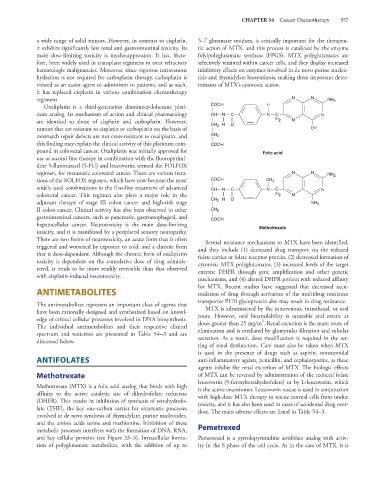Page 971 - Basic _ Clinical Pharmacology ( PDFDrive )
P. 971
CHAPTER 54 Cancer Chemotherapy 957
a wide range of solid tumors. However, in contrast to cisplatin, 5–7 glutamate residues, is critically important for the therapeu-
it exhibits significantly less renal and gastrointestinal toxicity. Its tic action of MTX, and this process is catalyzed by the enzyme
main dose-limiting toxicity is myelosuppression. It has, there- folylpolyglutamate synthase (FPGS). MTX polyglutamates are
fore, been widely used in transplant regimens to treat refractory selectively retained within cancer cells, and they display increased
hematologic malignancies. Moreover, since vigorous intravenous inhibitory effects on enzymes involved in de novo purine nucleo-
hydration is not required for carboplatin therapy, carboplatin is tide and thymidylate biosynthesis, making them important deter-
viewed as an easier agent to administer to patients, and as such, minants of MTX’s cytotoxic action.
it has replaced cisplatin in various combination chemotherapy
regimens. N N NH 2
Oxaliplatin is a third-generation diaminocyclohexane plati- COOH H
num analog. Its mechanism of action and clinical pharmacology CH N C N C N
are identical to those of cisplatin and carboplatin. However, CH H O H 2 N
tumors that are resistant to cisplatin or carboplatin on the basis of 2 OH
mismatch repair defects are not cross-resistant to oxaliplatin, and CH 2
this finding may explain the clinical activity of this platinum com- COOH
pound in colorectal cancer. Oxaliplatin was initially approved for Folic acid
use as second-line therapy in combination with the fluoropyrimi-
dine 5-fluorouracil (5-FU) and leucovorin, termed the FOLFOX
regimen, for metastatic colorectal cancer. There are various itera- N N NH 2
tions of the FOLFOX regimen, which have now become the most COOH CH 3
widely used combinations in the first-line treatment of advanced CH N C N C N
colorectal cancer. This regimen also plays a major role in the H 2 N
adjuvant therapy of stage III colon cancer and high-risk stage CH 2 H O NH 2
II colon cancer. Clinical activity has also been observed in other CH 2
gastrointestinal cancers, such as pancreatic, gastroesophageal, and COOH
hepatocellular cancer. Neurotoxicity is the main dose-limiting
toxicity, and it is manifested by a peripheral sensory neuropathy. Methotrexate
There are two forms of neurotoxicity, an acute form that is often Several resistance mechanisms to MTX have been identified,
triggered and worsened by exposure to cold, and a chronic form and they include (1) decreased drug transport via the reduced
that is dose-dependent. Although the chronic form of oxaliplatin folate carrier or folate receptor protein, (2) decreased formation of
toxicity is dependent on the cumulative dose of drug adminis- cytotoxic MTX polyglutamates, (3) increased levels of the target
tered, it tends to be more readily reversible than that observed enzyme DHFR through gene amplification and other genetic
with cisplatin-induced neurotoxicity.
mechanisms, and (4) altered DHFR protein with reduced affinity
for MTX. Recent studies have suggested that decreased accu-
ANTIMETABOLITES mulation of drug through activation of the multidrug resistance
transporter P170 glycoprotein also may result in drug resistance.
The antimetabolites represent an important class of agents that MTX is administered by the intravenous, intrathecal, or oral
have been rationally designed and synthesized based on knowl- route. However, oral bioavailability is saturable and erratic at
edge of critical cellular processes involved in DNA biosynthesis. doses greater than 25 mg/m . Renal excretion is the main route of
2
The individual antimetabolites and their respective clinical elimination and is mediated by glomerular filtration and tubular
spectrum and toxicities are presented in Table 54–3 and are secretion. As a result, dose modification is required in the set-
discussed below.
ting of renal dysfunction. Care must also be taken when MTX
is used in the presence of drugs such as aspirin, nonsteroidal
ANTIFOLATES anti-inflammatory agents, penicillin, and cephalosporins, as these
agents inhibit the renal excretion of MTX. The biologic effects
Methotrexate of MTX can be reversed by administration of the reduced folate
leucovorin (5-formyltetrahydrofolate) or by L-leucovorin, which
Methotrexate (MTX) is a folic acid analog that binds with high is the active enantiomer. Leucovorin rescue is used in conjunction
affinity to the active catalytic site of dihydrofolate reductase with high-dose MTX therapy to rescue normal cells from undue
(DHFR). This results in inhibition of synthesis of tetrahydrofo- toxicity, and it has also been used in cases of accidental drug over-
late (THF), the key one-carbon carrier for enzymatic processes dose. The main adverse effects are listed in Table 54–3.
involved in de novo synthesis of thymidylate, purine nucleotides,
and the amino acids serine and methionine. Inhibition of these
metabolic processes interferes with the formation of DNA, RNA, Pemetrexed
and key cellular proteins (see Figure 33–3). Intracellular forma- Pemetrexed is a pyrrolopyrimidine antifolate analog with activ-
tion of polyglutamate metabolites, with the addition of up to ity in the S phase of the cell cycle. As in the case of MTX, it is

